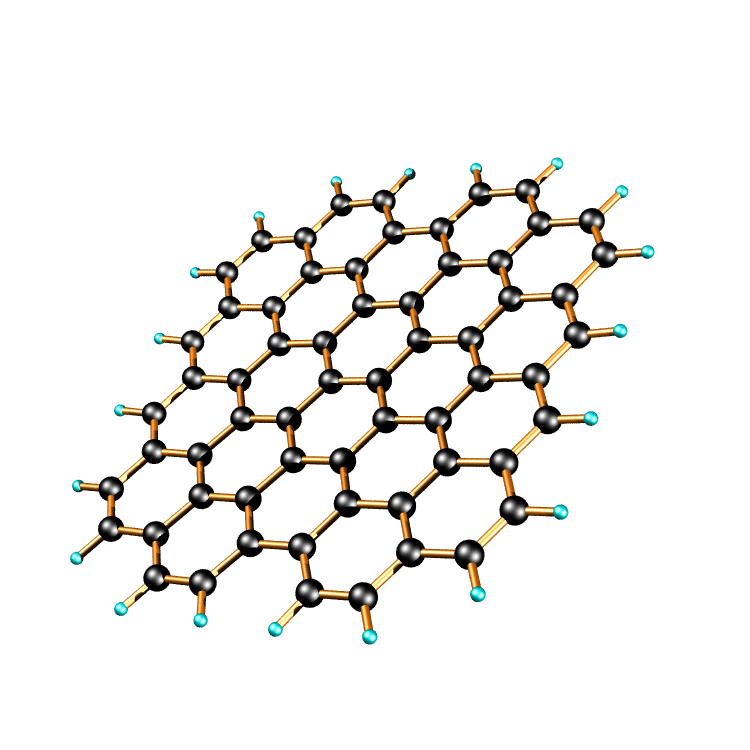Graphene Spintronics: Nanotech plus Electronics
 Take a carbon nanotube and flatten it out into a sheet, and you get graphene. A single layer sheet of graphite--a material with amazing electronic properties. One of the possibilities that graphene provides, is an opening into the new radical electronics called spintronics. Read on.
Take a carbon nanotube and flatten it out into a sheet, and you get graphene. A single layer sheet of graphite--a material with amazing electronic properties. One of the possibilities that graphene provides, is an opening into the new radical electronics called spintronics. Read on.Single sheets of graphene were only isolated in 2004 by Andre Geim (Univ. Manchester). In graphene, electron velocity is independent of energy. That is, electrons move as if they were light waves; they act as if they were massless particles.
This extraordinary property was elucidated in November 2005 through experiments (see background article in the Jan. 2006 Physics Today) using the quantum Hall effect (QHE), in which electrons, confined to a plane and subjected to high magnetic fields, execute only prescribed quantum trajectories.
...."This is really the first step in a very long path," he [de Heer of Georgia Tech] said. "We are at the proof-of principle stage, comparable to where transistors were in the late 1940s. We have a lot to do, but I believe this technology will advance rapidly."
The research, begun by de Heer's team in 2001, is supported by the U.S. National Science Foundation and the Intel Corporation.
In their paper, the researchers report seeing evidence of quantum confinement effects in their graphene circuitry, meaning electrons can move through it as waves. "The graphene ribbons we create are really like waveguides for electrons," de Heer said.
Because carbon nanotubes conduct electricity with virtually no resistance, they have attracted strong interest for use in transistors and other devices. However, the discrete nature of nanotubes – and variability in their properties – pose significant obstacles to their use in practical devices. By contrast, continuous graphene circuitry can be produced using standard microelectronics processing techniques.
"Nanotubes are simply graphene that has been rolled into a cylindrical shape," de Heer explained. "Using narrow ribbons of graphene, we can get all the properties of nanotubes because those properties are due to the graphene and the confinement of the electrons, not the nanotube structures."
De Heer envisions using the graphene electronics for specialized applications, potentially within conventional silicon-based systems.
"We have shown that we can interconnect graphene, put current into it, and take current out," he said. "We have a very promising electronic material. We see graphene as a platform, a canvas on which we can work."
....the Manchester researchers have shown that graphene can be fashioned into a device called a spin valve, which discriminates between mobile electrons according to their spin. Spin is a quantum-mechanical property of electrons, and can take either of two values - somewhat akin to magnets that can orient their poles in either of two opposed directions. Conventional electronics takes no account of electron spin; but it has been suggested that a spin-dependent form of electronics, called spintronics, could provide new and powerful ways to process information. A graphene spin valve could act rather like a spintronic filter that lets a current pass only if the electrons have the correct spin.
....Using electron beam lithography, they've created feature sizes as small as 80 nanometers – on the way toward a goal of 10 nanometers with the help of a new nanolithographer in Georgia Tech's Microelectronics Research Center.
The graphene circuitry demonstrates high electron mobility – up to 25,000 square centimeters per volt-second, showing that electrons move with little scattering. The researchers have also shown electronic coherence at near room temperature, and evidence of quantum interference effects. They expect to see ballistic transport when they make structures small enough.
So far, they have built an all graphene planar field-effect transistor. The side-gated device produces a change in resistance through its channel when voltage is applied to the gate. However, this first device has a substantial current leak, which the team expects to eliminate with minor processing adjustments.
The researchers have also built a working quantum interference device, a ring-shaped structure that would be useful in manipulating electronic waves.
The key to properties of the new circuitry is the width of the ribbons, which confine the electrons in a quantum effect similar to that seen in carbon nanotubes. The width of the ribbon controls the material's band-gap. Other structures, such as sensing molecules, could be attached to the edges of the ribbons, which are normally passivated by hydrogen atoms.
De Heer and collaborators began working on graphene in 2001 and received support from Intel in 2003. They later received a Nanoscale Interdisciplinary Research Team (NIRT) award from the U.S. National Science Foundation. They have filed one patent for their methods of fabricating graphene circuitry.
De Heer and his colleagues expect to continue improving their materials and fabrication processes, while producing and testing new structures. "We have taken the first step of a very long road," de Heer said. "Building a new class of electronics based on graphene is going to be very difficult and require the efforts of many people."
The italicized material above comes from four different articles, with the links provided at the beginning of the excerpt from each article. For background material, consult the wikipedia links in the opening paragraph.
The quantum world of electron spin is becoming more accessible to nanotechnology and electrical and electronics engineering. Spintronics promises to create electronics devices that are presently unimaginable.

0 Comments:
Post a Comment
“During times of universal deceit, telling the truth becomes a revolutionary act” _George Orwell
<< Home